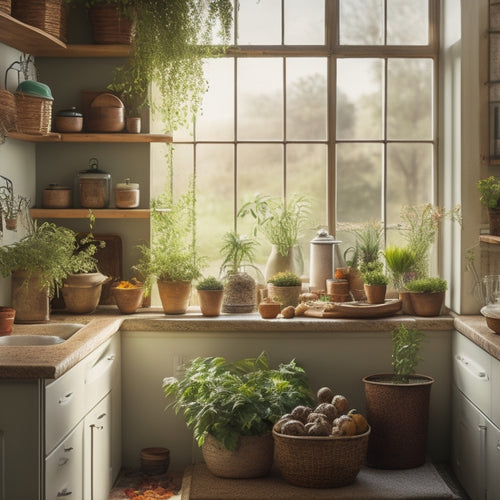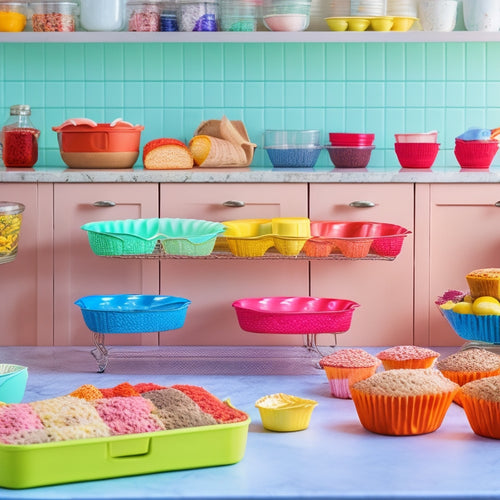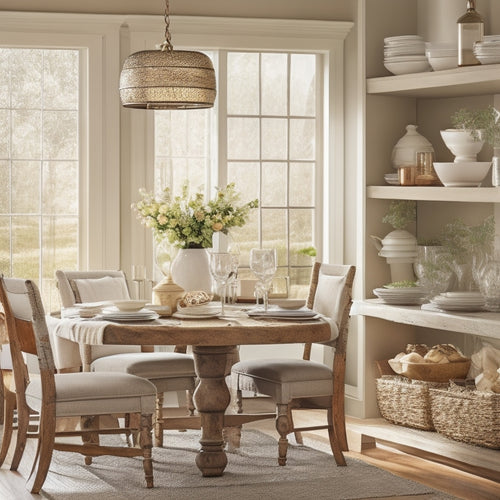
DIY Cabinet Construction Triumphs and Tutorial Review
Share
As I reflect on my DIY cabinet construction project, I'm reminded of the triumphant feeling I got from transforming a blank wall into a functional storage space that's both aesthetically pleasing and highly practical. I followed a precise process, taking accurate wall measurements, cutting wood with woodworking techniques, and routering front and back pieces for stability. The online community raved about my space-saving design, and I'm now planning to optimize kitchen functionality with additional storage solutions and exploring innovative storage designs. By following my DIY cabinet construction journey, you'll discover the secrets to creating a clutter-free cooking space that's both beautiful and functional.
Key Takeaways
• Precise wall measurements and woodworking techniques ensure accurate cuts and stability in DIY cabinet construction.
• Select pine is a cost-effective material option for cabinet construction without compromising on aesthetics.
• Adding custom finishes like casters and handles enhances functionality and design appeal.
• Dowels and reinforced joints provide precise alignment and strength to the cabinet structure.
• Sharing DIY cabinet designs online fosters community engagement, gathers valuable feedback, and inspires new projects.
DIY Cabinet Construction Process
I began my DIY cabinet construction process by taking precise wall measurements and marking the shelf placement with tape, guaranteeing a snug fit and efficient use of space.
Next, I applied my woodworking techniques to cut the wood accurately, although I did encounter a minor debate when the cut was shorter than desired.
To guarantee stability, I routered the front and back pieces for dual-sided use and screwed the outer box together. I opted for select pine to save on costs, and utilized a template to drill precise dowel holes.
After a quick sanding, staining, and polyurethane coating process, I added custom finishes, including casters and a handle.
Throughout the process, I prioritized safety and precision to create a sturdy and functional cabinet that meets my needs.
User Feedback and Design Inspiration
Positive reactions poured in from the online community, with many expressing admiration for the cabinet's space-saving design and enthusiasm for replicating the project in their own kitchens. I was thrilled to see how my DIY cabinet construction tutorial inspired others to create their own customized storage solutions.
| Design Element | Community Feedback | Design Inspiration |
|---|---|---|
| Space-saving design | "Love the compact design!" | Consider vertical storage for maximizing space |
| Customizable shelves | "How did you calculate shelf placement?" | Measure and adjust shelves to fit specific items |
| Material selection | "Using select pine was a great cost-saver!" | Explore alternative materials for durability and aesthetics |
| Casters and mobility | "Those casters make it so easy to move!" | Incorporate larger, fixed casters for smoother movement |
The feedback and design inspiration have been invaluable, and I'm excited to see how others will adapt and improve upon my design.
Future Storage and Organization Plans
What's next on the agenda is optimizing kitchen functionality and aesthetics with additional storage solutions, such as organizing spice and baking supplies.
I'm considering modifying my existing pantry or storage areas to create a more streamlined kitchen organization system. This will enable me to maximize storage capacity while maintaining easy accessibility to frequently used items.
I'm also exploring innovative storage solutions that can be integrated seamlessly into my kitchen design.
By prioritizing kitchen organization, I aim to create a more efficient and clutter-free cooking space that enhances my overall cooking experience.
With a focus on safety and practicality, I'm excited to commence on this next phase of my DIY cabinet construction journey.
Cost, Materials, and Practical Tips
Building on the success of my DIY cabinet construction, I've tallied up the estimated cost of materials and additional features, such as wheels, to provide a detailed breakdown for those looking to replicate this project. For budget-friendly alternatives, I opted for select pine, which saved me a significant amount without compromising on quality.
When sourcing materials, I recommend exploring local hardware stores or online suppliers for the best deals. To guarantee stability and safety, I added casters and a back panel, which can be sourced from most home improvement stores. Additionally, consider using dowels for precise alignment and reinforced joints for added strength.
Sharing and Community Engagement
I've been thrilled to share my DIY cabinet design on Pinterest and other platforms, sparking a wave of interest and requests to use my images in blog posts and articles. This community collaboration has been incredibly rewarding, and I'm excited to see how others are inspired to create their own versions.
| Sharing Inspiration | Community Engagement | Collaborative Benefits |
|---|---|---|
| Pinterest shares | Feedback and suggestions | Improved design iterations |
| Image requests | Community-driven Q&A | Enhanced safety considerations |
| Blog post features | Personal anecdotes and tips | Increased project visibility |
Through this sharing and community engagement, I've received valuable feedback, suggestions, and encouragement. It's amazing to see how this DIY project has brought people together, fostering a sense of community and collaboration.
Frequently Asked Questions
How Do I Ensure the Cabinet Remains Stable on Uneven Floors?
To guarantee my cabinet remains stable on uneven floors, I'll use anti-tip measures like anchoring it to the wall and incorporating leveling feet, securing a balanced installation that prevents accidents.
Can I Use MDF or Plywood Instead of Select Pine for the Shelves?
I opt for plywood over MDF for shelves due to its superior durability and moisture resistance, ensuring a sturdy corner design that can withstand weight and humidity, while customization options remain flexible.
What Is the Recommended Weight Capacity for the Casters Used?
When selecting casters, I guarantee caster durability by considering weight distribution, opting for heavy-duty models with a recommended capacity of at least 50 pounds per caster, and using floor levelers for added stability.
Are There Any Specific Safety Precautions for Installing the Cabinet Near Appliances?
When installing my cabinet near appliances, I guarantee safety by checking for uneven floors, securing the cabinet to the wall, and maintaining a safe distance from heat sources to prevent instability and damage.
Can I Customize the Design to Fit a Corner Space in My Kitchen?
"Did you know 75% of homeowners struggle with kitchen clutter? To customize my design for a corner space, I'd recommend adjusting the corner cabinet layout to maximize space-saving potential, ensuring a seamless fit and efficient storage."
Related Posts
-

Tiered Kitchen Rack Ideas for Small Spaces
Tiered kitchen racks are perfect for maximizing small spaces while adding style and functionality. Install wall-mount...
-

Roll-Out Trays for Organizing Baking Supplies
Roll-out trays are perfect for organizing your baking supplies, making your kitchen more efficient. They maximize spa...
-

Corner Cabinet Storage for Dinnerware Sets
Corner cabinet storage for dinnerware sets can change your kitchen into an organized, stylish space. By utilizing ver...


